[转]SSM(Spring+SpringMVC+Mybatis)框架搭建详细教程【附源代码Demo】
一、新建项目
运行IDEA,进入初始化界面,然后我们选择新建项目(进入主界面新建项目也是一样的)
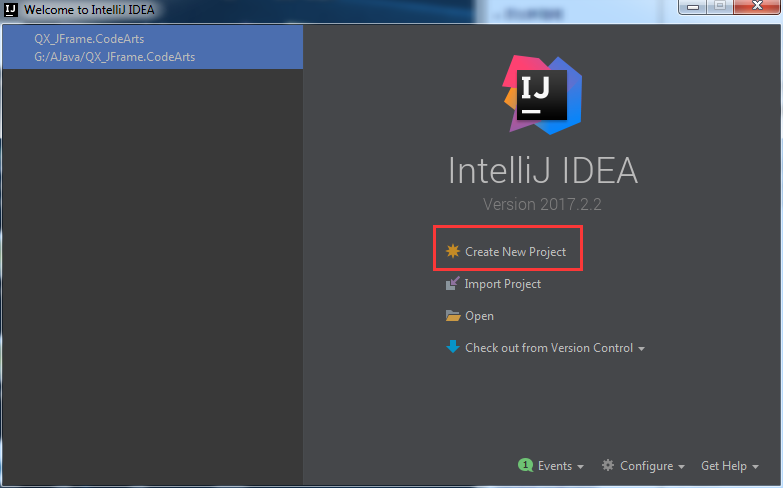
在Maven选项卡里面找到对应的java web选项,然后我们点下一步
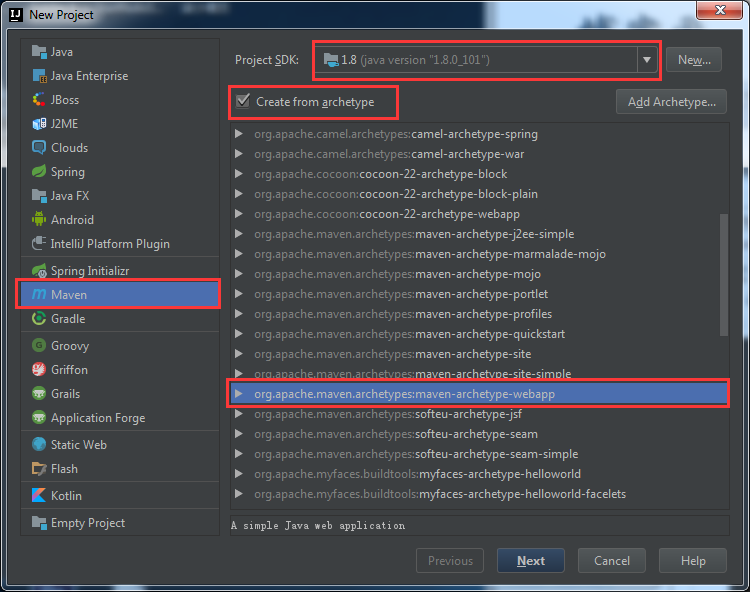
这一步填入组织等信息,这里比较随意,按照自己的需求进行填写,然后下一步
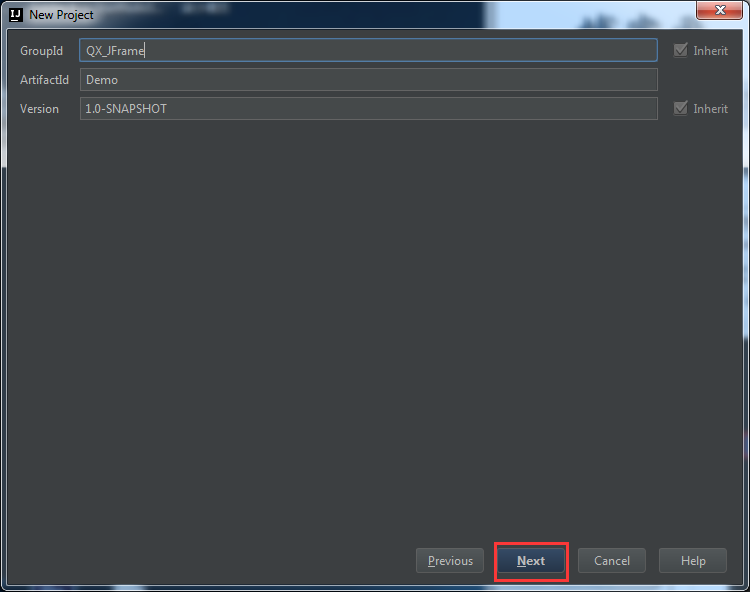
这里我早已配置好本地Maven仓库,因此直接默认即可。如果没进行配置本地默认仓库的话,请网上查找对应的资料进行配置
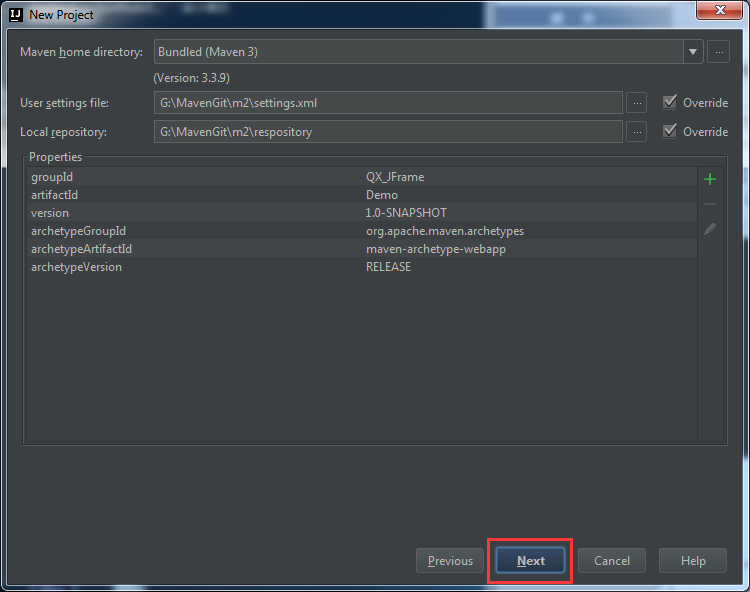
输入Project name,和需要保存的路径,然后finish

去泡一杯咖啡吧,这里需要一小段时间哦~
稍等片刻,idea已经为我们自动建好了一切。到这里,我们的第一步,新建项目阶段已经完成,欢庆一下,进入下一个阶段。

新建好项目后,我们首先打开SSM_Demo,修改一下JDK版本。


在settings里面对项目版本进行修改:

原来是1_5,现在改为1_8,可能会存在spring等框架版本和jdk版本不兼容问题,因此,提前升级了版本。
二、目录结构调整
首先我们配置Maven的项目结构,选择Project Structure
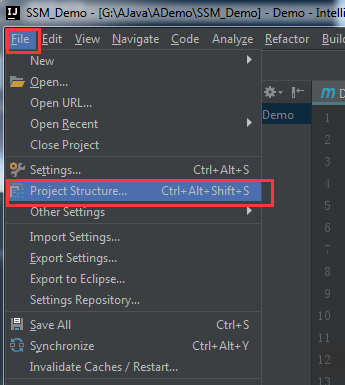
选择Modules标签页,然后新建并标识对应的项目结构
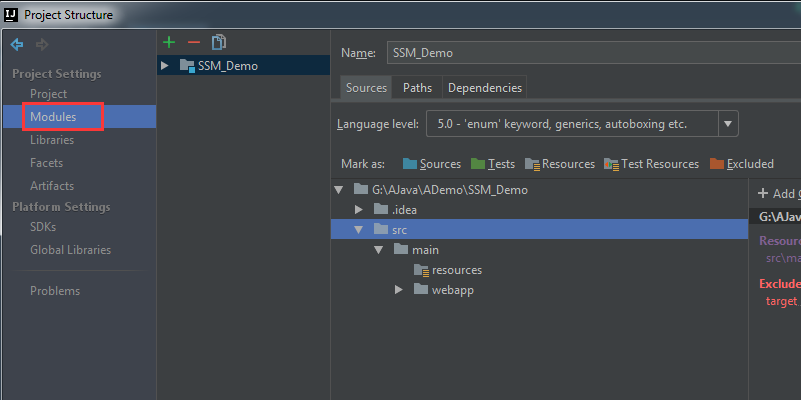
最终的文件结构如下所示:
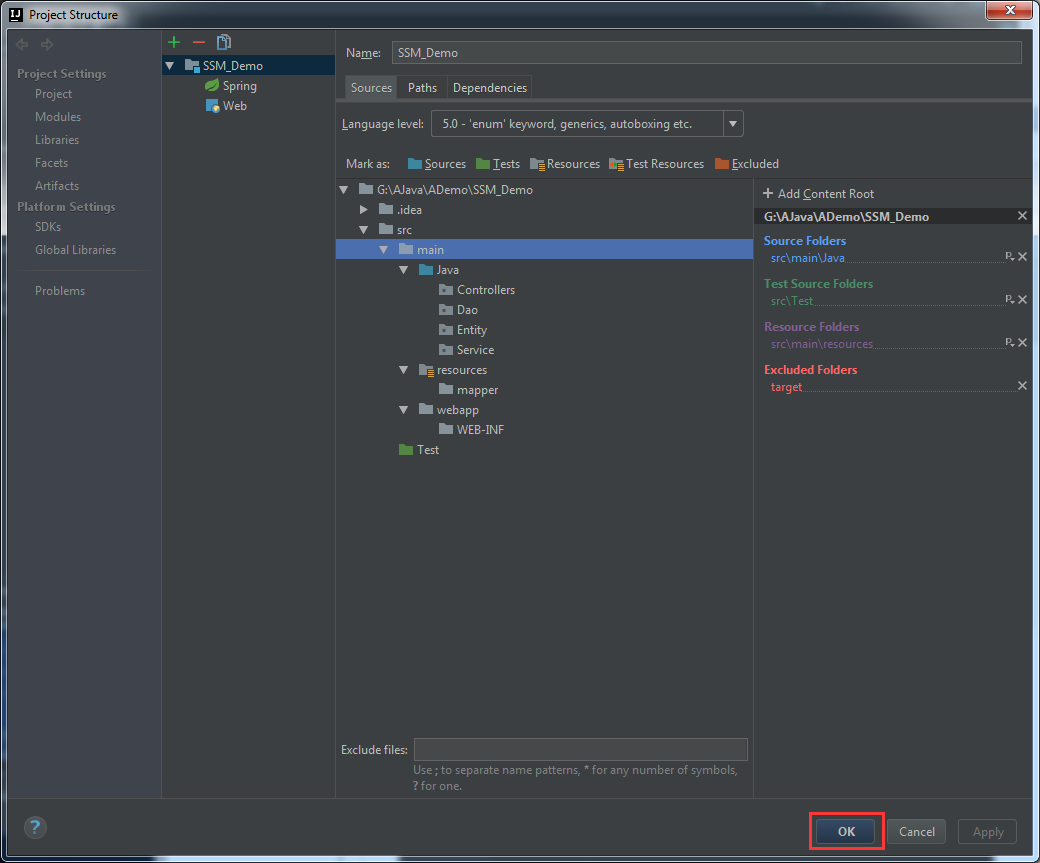

- Java为主Java代码文件夹
- Controllers 控制器文件文件夹
- Dao (数据访问)层文件夹
- Service(业务逻辑)层文件夹
- Entity(实体)层文件夹
- resources资源文件夹
- mapper mybatis sql文件夹
- webapp web页面文件夹
- Test 测试文件夹
三、Maven包的初始化
Maven是采用配置文件的方式进行jar包的自动导入,因此,我们需要进行对配置文件的修改来进行jar包的导入。
打开pom.xml文件
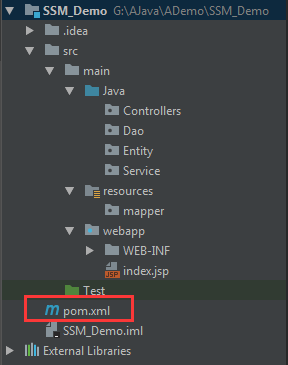
添加我们将会用到的一系列jar包配置(这里将我的配置直接复制过来,作为参考)

1 <project xmlns="http://maven.apache.org/POM/4.0.0" xmlns:xsi="http://www.w3.org/2001/XMLSchema-instance"
2 xsi:schemaLocation="http://maven.apache.org/POM/4.0.0 http://maven.apache.org/maven-v4_0_0.xsd">
3 <modelVersion>4.0.0</modelVersion>
4 <groupId>QX_JFrame</groupId>
5 <artifactId>Demo</artifactId>
6 <packaging>war</packaging>
7 <version>1.0-SNAPSHOT</version>
8 <name>Demo Maven Webapp</name>
9 <url>http://maven.apache.org</url>
10 <dependencies>
11 <!--Unit Test - 单元测试-->
12 <dependency>
13 <groupId>junit</groupId>
14 <artifactId>junit</artifactId>
15 <version>4.12</version>
17 </dependency>
18 <!--Spring-->
19 <dependency>
20 <groupId>org.springframework</groupId>
21 <artifactId>spring-core</artifactId>
22 <version>4.3.5.RELEASE</version>
23 </dependency>
24 <dependency>
25 <groupId>org.springframework</groupId>
26 <artifactId>spring-aop</artifactId>
27 <version>4.3.5.RELEASE</version>
28 </dependency>
29 <dependency>
30 <groupId>org.springframework</groupId>
31 <artifactId>spring-orm</artifactId>
32 <version>4.3.5.RELEASE</version>
33 </dependency>
34 <!--Spring transaction-->
35 <dependency>
36 <groupId>org.springframework</groupId>
37 <artifactId>spring-tx</artifactId>
38 <version>4.3.5.RELEASE</version>
39 </dependency>
40 <dependency>
41 <groupId>org.springframework</groupId>
42 <artifactId>spring-test</artifactId>
43 <version>4.3.5.RELEASE</version>
44 </dependency>
45 <dependency>
46 <groupId>org.springframework</groupId>
47 <artifactId>spring-mock</artifactId>
48 <version>2.0.8</version>
49 </dependency>
50 <dependency>
51 <groupId>org.springframework</groupId>
52 <artifactId>spring-jdbc</artifactId>
53 <version>4.3.5.RELEASE</version>
54 </dependency>
55 <dependency>
56 <groupId>org.springframework</groupId>
57 <artifactId>spring-context</artifactId>
58 <version>4.3.5.RELEASE</version>
59 </dependency>
60 <dependency>
61 <groupId>org.springframework</groupId>
62 <artifactId>spring-context-support</artifactId>
63 <version>4.3.5.RELEASE</version>
64 </dependency>
65 <dependency>
66 <groupId>org.springframework</groupId>
67 <artifactId>spring-expression</artifactId>
68 <version>4.3.5.RELEASE</version>
69 </dependency>
70 <!--Spring Web + Spring MVC-->
71 <dependency>
72 <groupId>org.springframework</groupId>
73 <artifactId>spring-web</artifactId>
74 <version>4.3.1.RELEASE</version>
75 </dependency>
76 <dependency>
77 <groupId>org.springframework</groupId>
78 <artifactId>spring-webmvc</artifactId>
79 <version>4.3.1.RELEASE</version>
80 </dependency>
81
82 <dependency>
83 <groupId>com.github.pagehelper</groupId>
84 <artifactId>pagehelper</artifactId>
85 <version>3.7.3</version>
86 </dependency>
87 <dependency>
88 <groupId>com.github.jsqlparser</groupId>
89 <artifactId>jsqlparser</artifactId>
90 <version>0.9.1</version>
91 </dependency>
92 <!--mysql jdbc-->
93 <dependency>
94 <groupId>mysql</groupId>
95 <artifactId>mysql-connector-java</artifactId>
96 <version>5.1.38</version>
97 </dependency>
98 <!--c3p0-->
99 <dependency>
100 <groupId>c3p0</groupId>
101 <artifactId>c3p0</artifactId>
102 <version>0.9.1.2</version>
103 </dependency>
104 <!--NoClassDefFoundError: javax/servlet/jsp/jstl/core/Config-->
105 <!-- https://mvnrepository.com/artifact/jstl/jstl -->
106 <dependency>
107 <groupId>jstl</groupId>
108 <artifactId>jstl</artifactId>
109 <version>1.2</version>
110 </dependency>
111 <!--file upload jar package-->
112 <!-- https://mvnrepository.com/artifact/commons-fileupload/commons-fileupload -->
113 <dependency>
114 <groupId>commons-fileupload</groupId>
115 <artifactId>commons-fileupload</artifactId>
116 <version>1.3.1</version>
117 </dependency>
118 <!-- https://mvnrepository.com/artifact/commons-io/commons-io -->
119 <dependency>
120 <groupId>commons-io</groupId>
121 <artifactId>commons-io</artifactId>
122 <version>2.4</version>
123 </dependency>
124 <!--json-->
125 <!-- https://mvnrepository.com/artifact/org.json/json -->
126 <dependency>
127 <groupId>org.json</groupId>
128 <artifactId>json</artifactId>
129 <version>20160212</version>
130 </dependency>
131 <!-- https://mvnrepository.com/artifact/net.sf.json-lib/json-lib -->
132 <dependency>
133 <groupId>net.sf.json-lib</groupId>
134 <artifactId>json-lib</artifactId>
135 <version>2.4</version>
136 </dependency>
137 <!-- https://mvnrepository.com/artifact/commons-lang/commons-lang -->
138 <dependency>
139 <groupId>commons-lang</groupId>
140 <artifactId>commons-lang</artifactId>
141 <version>2.6</version>
142 </dependency>
143 <!-- https://mvnrepository.com/artifact/commons-beanutils/commons-beanutils -->
144 <dependency>
145 <groupId>commons-beanutils</groupId>
146 <artifactId>commons-beanutils</artifactId>
147 <version>1.8.3</version>
148 </dependency>
149 <!-- https://mvnrepository.com/artifact/commons-collections/commons-collections -->
150 <dependency>
151 <groupId>commons-collections</groupId>
152 <artifactId>commons-collections</artifactId>
153 <version>3.2.1</version>
154 </dependency>
155 <!-- https://mvnrepository.com/artifact/commons-logging/commons-logging -->
156 <dependency>
157 <groupId>commons-logging</groupId>
158 <artifactId>commons-logging</artifactId>
159 <version>1.2</version>
160 </dependency>
161 <!-- https://mvnrepository.com/artifact/net.sf.ezmorph/ezmorph -->
162 <dependency>
163 <groupId>net.sf.ezmorph</groupId>
164 <artifactId>ezmorph</artifactId>
165 <version>1.0.6</version>
166 </dependency>
167 <!--json serialize and deserialization-->
168 <!-- 引入fastjson依赖 -->
169 <dependency>
170 <groupId>com.alibaba</groupId>
171 <artifactId>fastjson</artifactId>
172 <version>1.2.12</version>
173 </dependency>
174 <!-- 引入gson依赖 -->
175 <dependency>
176 <groupId>com.google.code.gson</groupId>
177 <artifactId>gson</artifactId>
178 <version>2.6.2</version>
179 </dependency>
180 <!--Base64 加解密-->
181 <!-- https://mvnrepository.com/artifact/net.iharder/base64 -->
182 <dependency>
183 <groupId>net.iharder</groupId>
184 <artifactId>base64</artifactId>
185 <version>2.3.8</version>
186 </dependency>
187 <!-- https://mvnrepository.com/artifact/commons-codec/commons-codec -->
188 <dependency>
189 <groupId>commons-codec</groupId>
190 <artifactId>commons-codec</artifactId>
191 <version>1.10</version>
192 </dependency>
193 <!--log4j-->
194 <!-- https://mvnrepository.com/artifact/org.apache.logging.log4j/log4j-core -->
195 <dependency>
196 <groupId>org.apache.logging.log4j</groupId>
197 <artifactId>log4j-core</artifactId>
198 <version>2.6.2</version>
199 </dependency>
200 <dependency>
201 <groupId>org.jetbrains</groupId>
202 <artifactId>annotations-java5</artifactId>
203 <version>RELEASE</version>
204 </dependency>
205 <!--mybatis-->
206 <dependency>
207 <groupId>org.mybatis</groupId>
208 <artifactId>mybatis</artifactId>
209 <version>3.3.0</version>
210 </dependency>
211 <dependency>
212 <groupId>org.mybatis</groupId>
213 <artifactId>mybatis-spring</artifactId>
214 <version>1.2.3</version>
215 </dependency>
216 </dependencies>
217 <build>
218 <finalName>Demo</finalName>
219 </build>
220 </project>

待配置好的jar包都自动下载并导入后,我们maven包的导入阶段就完成了,下面我们开始整合各个组件。
四、Spring MVC的配置
在resources资源文件夹下新建spring-servlet.xml文件,并在配置文件中声明spring mvc框架对控制器、页面、资源的访问

在其中添加下面配置标签信息:

1 <?xml version="1.0" encoding="UTF-8"?>
2 <beans xmlns="http://www.springframework.org/schema/beans"
3 xmlns:xsi="http://www.w3.org/2001/XMLSchema-instance"
4 xmlns:context="http://www.springframework.org/schema/context"
5 xmlns:mvc="http://www.springframework.org/schema/mvc"
6 xsi:schemaLocation="http://www.springframework.org/schema/beans
7 http://www.springframework.org/schema/beans/spring-beans-3.1.xsd
8 http://www.springframework.org/schema/context
9 http://www.springframework.org/schema/context/spring-context-3.1.xsd
10 http://www.springframework.org/schema/mvc
11 http://www.springframework.org/schema/mvc/spring-mvc-3.1.xsd">
12
13 <!-- 启动注解驱动的Spring MVC功能,注册请求url和注解POJO类方法的映射-->
14 <mvc:annotation-driven >
15
16 </mvc:annotation-driven>
17
18 <!-- 启动包扫描功能,以便注册带有@Controllers、@service、@repository、@Component等注解的类成为spring的bean -->
19 <context:component-scan base-package="Controllers" />
20 <!-- 对模型视图名称的解析,在请求时模型视图名称添加前后缀 -->
21 <bean class="org.springframework.web.servlet.view.InternalResourceViewResolver">
22 <property name="viewClass" value="org.springframework.web.servlet.view.JstlView"/>
23 <property name="prefix" value="/"/> <!-- 前缀 -->
24 <property name="suffix" value=".jsp"/> <!-- 后缀 -->
25 </bean>
26 <!-- 访问静态文件(jpg,js,css)的方法 -->
27 <!--<mvc:resources location="/files/" mapping="/files/**" />-->
28 <!--<mvc:resources location="/scripts/" mapping="/scripts/**" />-->
29 <!--<mvc:resources location="/styles/" mapping="/styles/**" />-->
30 <!--<mvc:resources location="/Views/" mapping="/Views/**" />-->
31 </beans>


这里的Controllers对应的是我们之前新建好的Controllers包文件夹。
对web.xml进行配置,将我们刚才添加的spring-servlet.xml配置进去


这里的classpath为resources资源目录
这一步配置的web.xml内容如下:

1 <!DOCTYPE web-app PUBLIC
2 "-//Sun Microsystems, Inc.//DTD Web Application 2.3//EN"
3 "http://java.sun.com/dtd/web-app_2_3.dtd" >
4 <web-app xmlns:xsi="http://www.w3.org/2001/XMLSchema-instance"
5 xmlns="http://java.sun.com/xml/ns/javaee"
6 xsi:schemaLocation="http://java.sun.com/xml/ns/javaee http://java.sun.com/xml/ns/javaee/web-app_3_0.xsd"
7 version="3.0">
8 <display-name>Archetype Created Web Application</display-name>
9 <welcome-file-list>
10 <welcome-file>/index.jsp</welcome-file>
11 </welcome-file-list>
12 <!-- Spring MVC配置 -->
13 <servlet>
14 <servlet-name>spring</servlet-name>
15 <servlet-class>org.springframework.web.servlet.DispatcherServlet</servlet-class>
16 <!--Spring-servlet.xml config-->
17 <init-param>
18 <param-name>contextConfigLocation</param-name>
19 <param-value>classpath:spring-servlet.xml</param-value>
20 </init-param>
21 <!-- load-on-startup元素标记容器是否在启动的时候就加载这个servlet(实例化并调用其init()方法) -->
22 <load-on-startup>1</load-on-startup>
23 </servlet>
24 <servlet-mapping>
25 <servlet-name>spring</servlet-name>
26 <url-pattern>/</url-pattern>
27 </servlet-mapping>
28 </web-app>

我们新建一个控制器测试一下(在Controllers包新建java类,RequestTestController):

接下来在RequestTestController里面写一个rest api接口:

接口代码如下:

1 package Controllers;
2
3 import org.springframework.web.bind.annotation.GetMapping;
4 import org.springframework.web.bind.annotation.RequestMapping;
5 import org.springframework.web.bind.annotation.RestController;
6
7 @RestController
8 @RequestMapping("/api/RequestTest")
9 public class RequestTestController {
10
11 @GetMapping()
12 public String TestString(){
13 return "this is a test string. Time:2017-10-29 20:42:00";
14 }
15 }

这样,我们便可以通过url地址来进行访问我们的接口数据

在右上角的运行服务器配置按钮,打开服务器配置项

这里如果左侧列表是空的话,我们就需要点击加号进行服务器的添加,选择Tomcat Server下的Local。然后点击刚刚添加的标签,在右侧输入Server Name,下面会自动提示设置编译方式,选一个编译方式,然后点击OK即可(这一步的前提是装好了Tomcat服务器,如果没有安装,则需要先安装Tomcat服务器)。
然后我们点击右上角的运行,如果没有什么问题的话,我们的控制台界面会提示服务启动成功!(我这样下来是不会出问题的)

等浏览器打开以后,我们输入我们配置的api地址:http://localhost:8080/api/RequestTest

这样,spring mvc已经成功整合到了项目里面!
五、Spring和Mybatis的配置
稍歇片刻后,我们继续进行Mybatis和Spring组件的整合...
先添加jdbc.properties(JDBC连接配置文件,当然这个文件里面的内容直接写到mybatis配置文件里面也是可以的)

内容如下:
继续在resources文件夹里面添加mybatis配置文件 spring-mybatis.xml
内容如下:
添加spring支持(applicationContext.xml),并在spring支持里面将mybatis配置文件进行引入
内容如下:

1 <?xml version="1.0" encoding="UTF-8"?>
2 <beans
3 xmlns="http://www.springframework.org/schema/beans"
4 xmlns:xsi="http://www.w3.org/2001/XMLSchema-instance"
5 xmlns:context="http://www.springframework.org/schema/context"
6 xsi:schemaLocation="http://www.springframework.org/schema/beans http://www.springframework.org/schema/beans/spring-beans-3.1.xsd http://www.springframework.org/schema/context http://www.springframework.org/schema/context/spring-context.xsd">
7
8 <context:annotation-config />
9 <!-- 配置component所在的包,自动加载需要管理的Bean -->
10 <context:component-scan base-package="Service,Dao" />
11 <import resource="spring-mybatis.xml" />
12 </beans>

applicationContext.xml配置文件是对spring的配置,我们配置spring组件的扫描包围Service和Dao层目录,然后将spring-mybatis.xml配置文件导入.
完成这三个后的文件目录是这样子的:

target文件夹是刚才编译运行时候自动产生的,不要惊慌~~~
完成这几步后,我们还需要将spring的配置加载到已有的框架中去,打开web.xml文件,进行添加spring配置
在刚才的web-app标签内继续添加spring支持:

此刻完整的web.xml文件内容如下:
到此刻,我们的spring、mybatis已经整合完毕,接下来稍歇片刻,我们进行demo的完成。
六、demo的构建
打开数据库,我们新建一个数据库,并设计两张测试表,student和studentclass

student表的设计如下:


-- ----------------------------
-- Table structure for `student`
-- ----------------------------
DROP TABLE IF EXISTS `student`;
CREATE TABLE `student` (
`Uid` binary(36) NOT NULL COMMENT 'Uid',
`Name` varchar(20) NOT NULL,
`Age` int(3) NOT NULL,
`ClassId` int(3) NOT NULL,
PRIMARY KEY (`Uid`),
KEY `StudentClass` (`ClassId`),
CONSTRAINT `StudentClass` FOREIGN KEY (`ClassId`) REFERENCES `studentclass` (`ClassId`)
) ENGINE=InnoDB DEFAULT CHARSET=utf8;

studentclass表的设计如下:


-- ----------------------------
-- Table structure for `studentclass`
-- ----------------------------
DROP TABLE IF EXISTS `studentclass`;
CREATE TABLE `studentclass` (
`ClassId` int(3) NOT NULL AUTO_INCREMENT,
`ClassName` varchar(10) DEFAULT NULL,
PRIMARY KEY (`ClassId`)
) ENGINE=InnoDB AUTO_INCREMENT=6 DEFAULT CHARSET=utf8;

将数据库建好后,我们进行Entity,Dao,Service层以及mapper文件的的编写。
首先在mapper文件夹新建一个mapper文件:StudentMapper.xml

1 <?xml version="1.0" encoding="UTF-8"?>
2 <!DOCTYPE mapper PUBLIC "-//mybatis.org//DTD Mapper 3.0//EN" "http://mybatis.org/dtd/mybatis-3-mapper.dtd">
3 <mapper namespace="Dao.StudentMapper">
4 <resultMap id="BaseResultMap" type="Entity.Student">
5 <id column="Uid" jdbcType="BINARY" property="uid" />
6 <result column="Name" jdbcType="VARCHAR" property="name" />
7 <result column="Age" jdbcType="INTEGER" property="age" />
8 <result column="ClassId" jdbcType="INTEGER" property="classid" />
9 </resultMap>
10 <sql id="Base_Column_List">
11 Uid, Name, Age, ClassId
12 </sql>
13 <select id="selectByPrimaryKey" parameterType="byte[]" resultMap="BaseResultMap">
14 select
15 <include refid="Base_Column_List" />
16 from student
17 where Uid = #{uid,jdbcType=BINARY}
18 </select>
19 <select id="selectByCondition" parameterType="Entity.Student" resultMap="BaseResultMap">
20 SELECT
21 <include refid="Base_Column_List"/>
22 from student
23 <where>
24 1=1
25 <if test="uid != null">
26 and Uid=#{uid,jdbcType=BINARY}
27 </if>
28 <if test="name != null">
29 and Name=#{name,jdbcType=VARCHAR}
30 </if>
31 <if test="age != null">
32 and Age=#{age,jdbcType=INTEGER}
33 </if>
34 <if test="classid != null">
35 and ClassId=#{classid,jdbcType=INTEGER}
36 </if>
37 </where>
38 </select>
39 <delete id="deleteByPrimaryKey" parameterType="byte[]">
40 delete from student
41 where Uid = #{uid,jdbcType=BINARY}
42 </delete>
43 <insert id="insert" parameterType="Entity.Student">
44 insert into student (Uid, Name, Age,
45 ClassId)
46 values (#{uid,jdbcType=BINARY}, #{name,jdbcType=VARCHAR}, #{age,jdbcType=INTEGER},
47 #{classid,jdbcType=INTEGER})
48 </insert>
49 <insert id="insertSelective" parameterType="Entity.Student">
50 insert into student
51 <trim prefix="(" suffix=")" suffixOverrides=",">
52 <if test="uid != null">
53 Uid,
54 </if>
55 <if test="name != null">
56 Name,
57 </if>
58 <if test="age != null">
59 Age,
60 </if>
61 <if test="classid != null">
62 ClassId,
63 </if>
64 </trim>
65 <trim prefix="values (" suffix=")" suffixOverrides=",">
66 <if test="uid != null">
67 #{uid,jdbcType=BINARY},
68 </if>
69 <if test="name != null">
70 #{name,jdbcType=VARCHAR},
71 </if>
72 <if test="age != null">
73 #{age,jdbcType=INTEGER},
74 </if>
75 <if test="classid != null">
76 #{classid,jdbcType=INTEGER},
77 </if>
78 </trim>
79 </insert>
80 <update id="updateByPrimaryKeySelective" parameterType="Entity.Student">
81 update student
82 <set>
83 <if test="name != null">
84 Name = #{name,jdbcType=VARCHAR},
85 </if>
86 <if test="age != null">
87 Age = #{age,jdbcType=INTEGER},
88 </if>
89 <if test="classid != null">
90 ClassId = #{classid,jdbcType=INTEGER},
91 </if>
92 </set>
93 where Uid = #{uid,jdbcType=BINARY}
94 </update>
95 <update id="updateByPrimaryKey" parameterType="Entity.Student">
96 update student
97 set Name = #{name,jdbcType=VARCHAR},
98 Age = #{age,jdbcType=INTEGER},
99 ClassId = #{classid,jdbcType=INTEGER}
100 where Uid = #{uid,jdbcType=BINARY}
101 </update>
102 </mapper>

以上这段代码是直接使用mybatis generator直接进行生成的,如果不想手写的话(手写容易出错),可以直接使用该工具进行生成,该工具的下载以及使用参见本人博客地址:http://www.cnblogs.com/qixiaoyizhan/p/7597315.html
添加Entity实体


1 package Entity;
2
3 public class Student {
4 private byte[] uid;
5
6 private String name;
7
8 private Integer age;
9
10 private Integer classid;
11
12 public byte[] getUid() {
13 return uid;
14 }
15
16 public void setUid(byte[] uid) {
17 this.uid = uid;
18 }
19
20 public String getName() {
21 return name;
22 }
23
24 public void setName(String name) {
25 this.name = name == null ? null : name.trim();
26 }
27
28 public Integer getAge() {
29 return age;
30 }
31
32 public void setAge(Integer age) {
33 this.age = age;
34 }
35
36 public Integer getClassid() {
37 return classid;
38 }
39
40 public void setClassid(Integer classid) {
41 this.classid = classid;
42 }
43 }

在Dao层写Mybatis接口(不需要写实现类,mybatis不需要),新建StudentMapper


1 package Dao;
2
3 import Entity.Student;
4 import org.springframework.stereotype.Repository;
5
6 import java.util.List;
7
8 @Repository
9 public interface StudentMapper {
10 int deleteByPrimaryKey(byte[] uid);
11
12 int insert(Student record);
13
14 int insertSelective(Student record);
15
16 Student selectByPrimaryKey(byte[] uid);
17
18 List<Student> selectByCondition(Student record);
19
20 int updateByPrimaryKeySelective(Student record);
21
22 int updateByPrimaryKey(Student record);
23 }

在Service层写对Dao层的访问逻辑,当然Demo没有什么业务处理逻辑,仅作为Demo

IStudentService 接口:

1 package Service;
2
3 import Entity.Student;
4
5 import java.util.List;
6
7 public interface IStudentService {
8 int deleteByPrimaryKey(byte[] uid);
9
10 int insert(Student record);
11
12 int insertSelective(Student record);
13
14 Student selectByPrimaryKey(byte[] uid);
15
16 List<Student> selectByCondition(Student record);
17
18 int updateByPrimaryKeySelective(Student record);
19
20 int updateByPrimaryKey(Student record);
21 }

StudentService 实现了 IStudentService 接口:

1 package Service;
2
3 import Dao.StudentMapper;
4 import Entity.Student;
5 import org.springframework.beans.factory.annotation.Autowired;
6 import org.springframework.stereotype.Service;
7
8 import java.util.List;
9
10 @Service
11 public class StudentService implements IStudentService {
12 @Autowired
13 private StudentMapper studentMapper;
14
15 @Override
16 public int deleteByPrimaryKey(byte[] uid) {
17 return studentMapper.deleteByPrimaryKey(uid);
18 }
19
20 @Override
21 public int insert(Student record) {
22 return studentMapper.insert(record);
23 }
24
25 @Override
26 public int insertSelective(Student record) {
27 return studentMapper.insertSelective(record);
28 }
29
30 @Override
31 public Student selectByPrimaryKey(byte[] uid) {
32 return studentMapper.selectByPrimaryKey(uid);
33 }
34
35 @Override
36 public List<Student> selectByCondition(Student record) {
37 return studentMapper.selectByCondition(record);
38 }
39
40 @Override
41 public int updateByPrimaryKeySelective(Student record) {
42 return studentMapper.updateByPrimaryKeySelective(record);
43 }
44
45 @Override
46 public int updateByPrimaryKey(Student record) {
47 return studentMapper.updateByPrimaryKey(record);
48 }
49 }

然后我们写一个StudentController用于调用Service


1 package Controllers;
2
3 import Entity.Student;
4 import Service.IStudentService;
5 import org.springframework.beans.factory.annotation.Autowired;
6 import org.springframework.web.bind.annotation.GetMapping;
7 import org.springframework.web.bind.annotation.RequestMapping;
8 import org.springframework.web.bind.annotation.RestController;
9
10 import java.util.List;
11
12 @RestController
13 @RequestMapping("/api/Student")
14 public class StudentController {
15 @Autowired
16 private IStudentService service;
17
18 @GetMapping()
19 public String Get() {
20 List<Student> students = service.selectByCondition(new Student());
21 String jsonResult = com.alibaba.fastjson.JSON.toJSONString(students);
22 return jsonResult;
23 }
24 }

走到这一步的代码目录结构是这样子的:
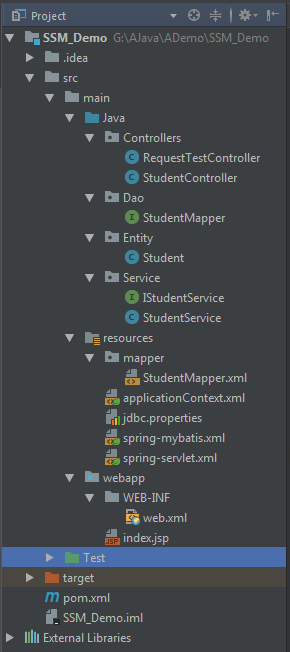
如果进行顺利的话,我们运行我们的Tomacat服务器,并调用我们的新接口:http://localhost:8080/api/Student
运行时候,别忘记了修改jdbc.properties文件里的连接url以及用户名密码!!!


哇,数据成功显示!(别把这个数据当成你会真的显示出来的一样,这是我数据库原有的数据,哈哈哈)
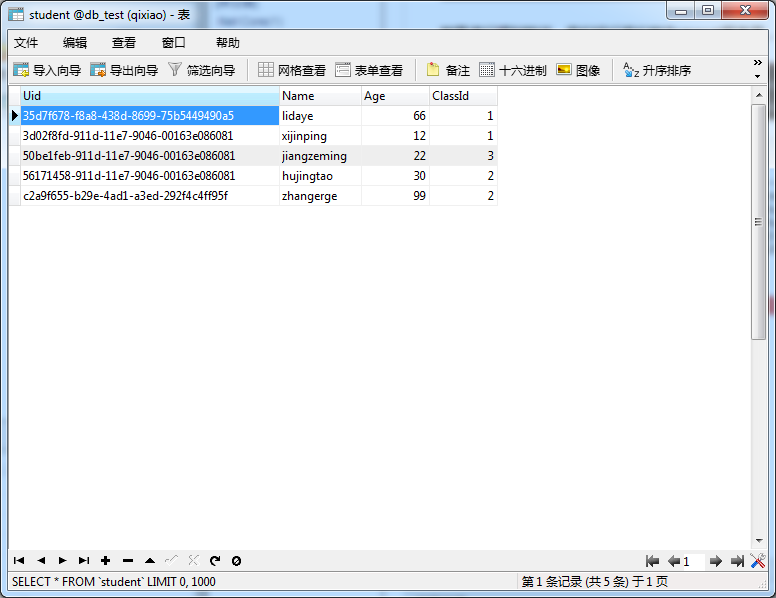
还不快去添加几条数据调用一下试试嘛~
七、结尾
至此,我们的SSM框架已经基本搭建完毕,我们已经用我们搭建的Demo从真实的数据库中获取到了数据,并转成了Json格式,在浏览器中用Rest api接口的形式获取到了。
该项目源代码可以在Github上找到,如果需要的可以直接去下载->
https://github.com/dong666/SSM-Demo (不赶紧访问点个Star嘛?
 10.0.1.176:3306/db_test?characterEncoding=utf8 (IP:端口/数据库名)
10.0.1.176:3306/db_test?characterEncoding=utf8 (IP:端口/数据库名)[转]SSM(Spring+SpringMVC+Mybatis)框架搭建详细教程【附源代码Demo】的更多相关文章
- SSM(Spring +SpringMVC + Mybatis)框架搭建
SSM(Spring +SpringMVC + Mybatis)框架的搭建 最近通过学习别人博客发表的SSM搭建Demo,尝试去搭建一个简单的SSMDemo---实现的功能是对用户增删改查的操作 参考 ...
- 基于Maven的ssm(spring+springMvc+Mybatis)框架搭建
前言 本demo是在idea下搭建的maven项目,数据库使用Mysql,jdk版本是1.8.0_171,ideal:2017.3.5 一.新建项目 1.file->new->porjec ...
- SSM(Spring+SpringMVC+Mybatis)框架环境搭建(整合步骤)(一)
1. 前言 最近在写毕设过程中,重新梳理了一遍SSM框架,特此记录一下. 附上源码:https://gitee.com/niceyoo/jeenotes-ssm 2. 概述 在写代码之前我们先了解一下 ...
- SSM(Spring,SpringMVC,Mybatis)框架整合项目
快速上手SSM(Spring,SpringMVC,Mybatis)框架整合项目 环境要求: IDEA MySQL 8.0.25 Tomcat 9 Maven 3.6 数据库环境: 创建一个存放书籍数据 ...
- SSM(Spring + Springmvc + Mybatis)框架面试题
JAVA SSM框架基础面试题https://blog.csdn.net/qq_39031310/article/details/83050192 SSM(Spring + Springmvc + M ...
- SSM:spring+springmvc+mybatis框架中的XML配置文件功能详细解释(转)
原文:https://blog.csdn.net/yijiemamin/article/details/51156189# 这几天一直在整合SSM框架,虽然网上有很多已经整合好的,但是对于里面的配置文 ...
- 0927-转载:SSM:spring+springmvc+mybatis框架中的XML配置文件功能详细解释
这篇文章暂时只对框架中所要用到的配置文件进行解释说明,而且是针对注解形式的,框架运转的具体流程过两天再进行总结. spring+springmvc+mybatis框架中用到了三个XML配置文件:web ...
- SSM:spring+springmvc+mybatis框架中的XML配置文件功能详细解释
这几天一直在整合SSM框架,虽然网上有很多已经整合好的,但是对于里面的配置文件并没有进行过多的说明,很多人知其然不知其所以然,经过几天的搜索和整理,今天总算对其中的XML配置文件有了一定的了解,所以拿 ...
- SSM(Spring+SpringMVC+MyBatis)框架整合开发流程
回忆了 Spring.SpringMVC.MyBatis 框架整合,完善一个小demo,包括基本的增删改查功能. 开发环境 IDEA MySQL 5.7 Tomcat 9 Maven 3.2.5 需要 ...
- 【SSM 6】Spring+SpringMVC+Mybatis框架搭建步骤
一.整体概览 首先看maven工程的创建 二.各层的文件配置 2.1,SSM父工程 <span style="font-family:KaiTi_GB2312;font-size:18 ...
随机推荐
- leetcode.字符串.125验证回文串-Java
1. 具体题目 给定一个字符串,验证它是否是回文串,只考虑字母和数字字符,可以忽略字母的大小写.说明:本题中,我们将空字符串定义为有效的回文串. 示例 1: 输入: "A man, a pl ...
- [USACO10FEB]购买巧克力Chocolate Buying
题目描述 Bessie and the herd love chocolate so Farmer John is buying them some. The Bovine Chocolate Sto ...
- Vue双向数据绑定原理深度解析
首先,什么是双向数据绑定?Vue是三大MVVM框架之一,数据绑定简单来说,就是当数据发生变化时,相应的视图会进行更新,当视图更新时,数据也会跟着变化. 在分析其原理和代码的时候,大家首先了解如下几个j ...
- css盒子模型概念
CSS css盒子模型 又称框模型 (Box Model) ,包含了元素内容(content).内边距(padding).边框(border).外边距(margin)几个要素.如图: 图中最内部的框是 ...
- GitHub不能访问问题
在C:\Windows\System32\drivers\etc文件夹下HOSTS里面最后添加: 192.30.253.112 github.com 192.30.253.113 github.com ...
- Eclipse+Marven + spring mvc 新建一个 Hello world 项目
1. 打开Eclipse,菜单 File->New->Marven Project. 2. 点击 Next, 3. 选择 marv ...
- 一句话下载总结(用于后渗透上传payload)
利用ftp来下载payload文件 echo open 192.168.1.1 21> ftp.txt echo ftp>> ftp.txt echo bin >> ft ...
- NX二次开发-对话框解锁UF_UI_unlock_ug_access
VC/MFC调用UG Dialog要进入加锁状态 加锁 UF_UI_lock_ug_access ( UF_UI_FROM_CUSTOM ); 此处为UF_UI_select的函数 解锁 UF_UI_ ...
- 简介Python正则表达式
一.概念 简单来说正则表达式是由一些普通字符(例如,a 到 z 之间的字母)和一些元字符组成,用来匹配和过滤一些字符串的一种逻辑公式. 二.正则表达式的一些基本规则 1.一些常用的元字符 ^ : ...
- Spring源码由浅入深系列五 GetBean
获取bean的过程如上图所示.下一章将继续图示讲解createBean的过程.
